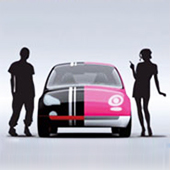The classic era ushered with the Great Depression in 1930 and ended around 1940 shortly before World War II. The cars of this period were less rectangular and industrial. The new automobiles were sleek and beautiful. The new technology allowed designers to create luxurious aerodynamic cars with big curves and deep arches. The new salon/sedan body style was made for cruising and even incorporated a trunk or boot at the rear for storage (Duncan 1998).
Le Corbusier had comparative analysis on cars (1921) with the Parthenon (431 BC) and Corbusier found many similarities between them (Banham 1972).
Automobile designers modeled their forms on airplanes and trains because these objects semantically carry the meaning of speed. Applying the airplane’s meaning to a car assured the automaker that its jalopies would look fast even if, in real, that was not the case (Beyer 2006). The wheels, lights and fenders hugged the body and articulated the safety and strength of the frame. Tires were wider and thicker than in the Capsule era adding to the solidity of the vehicles. The old open-top runabouts, phaetons, and touring cars were phased out by the end of the Classic era as wings, running boards, and headlights were gradually integrated into the body of the car. Integrated fenders and fully closed bodies began to dominate sales.

Fig.6 - The Classic era
References:
http://www.autobelle.it/archivio_carrozzieri/zagato.php

